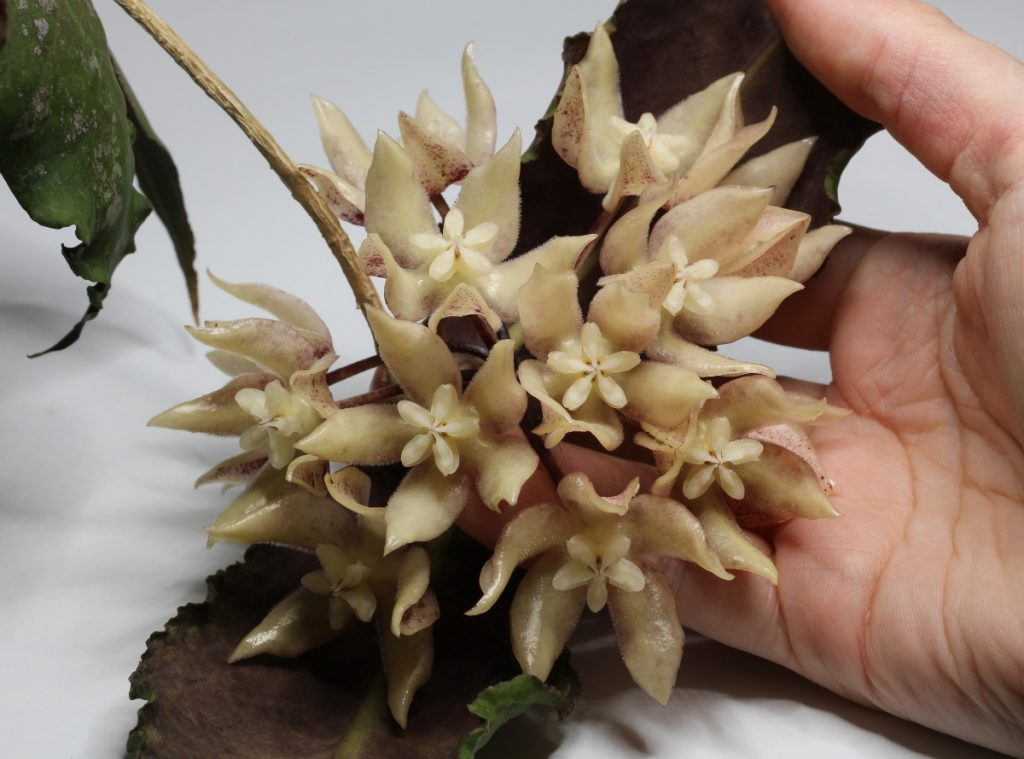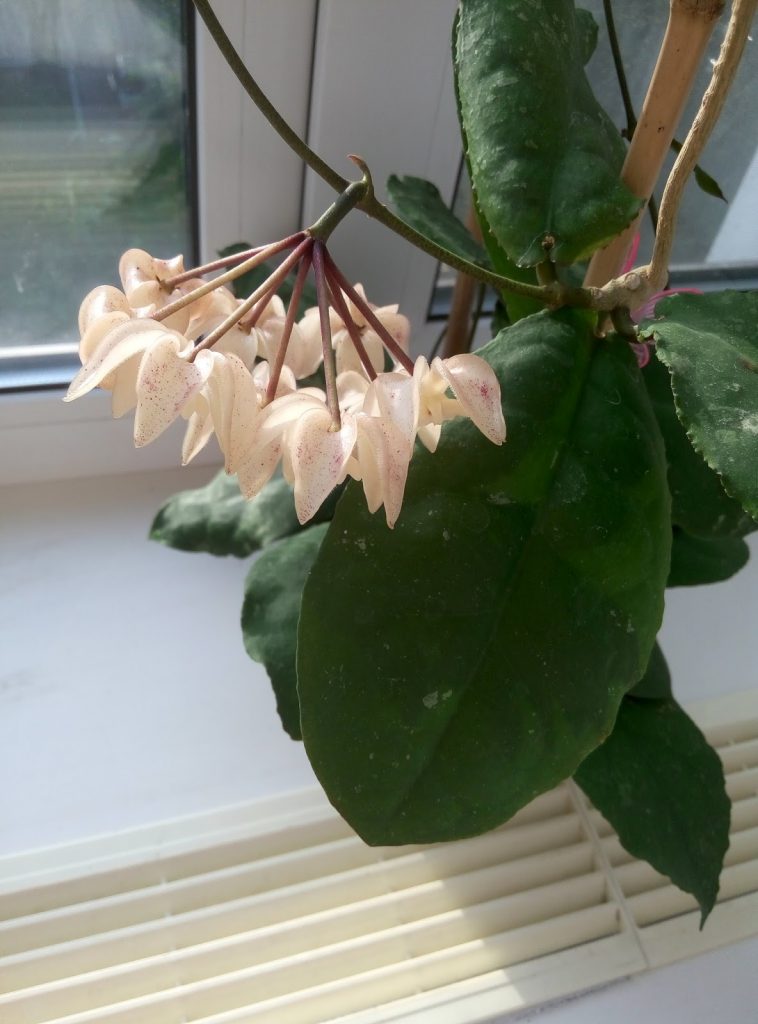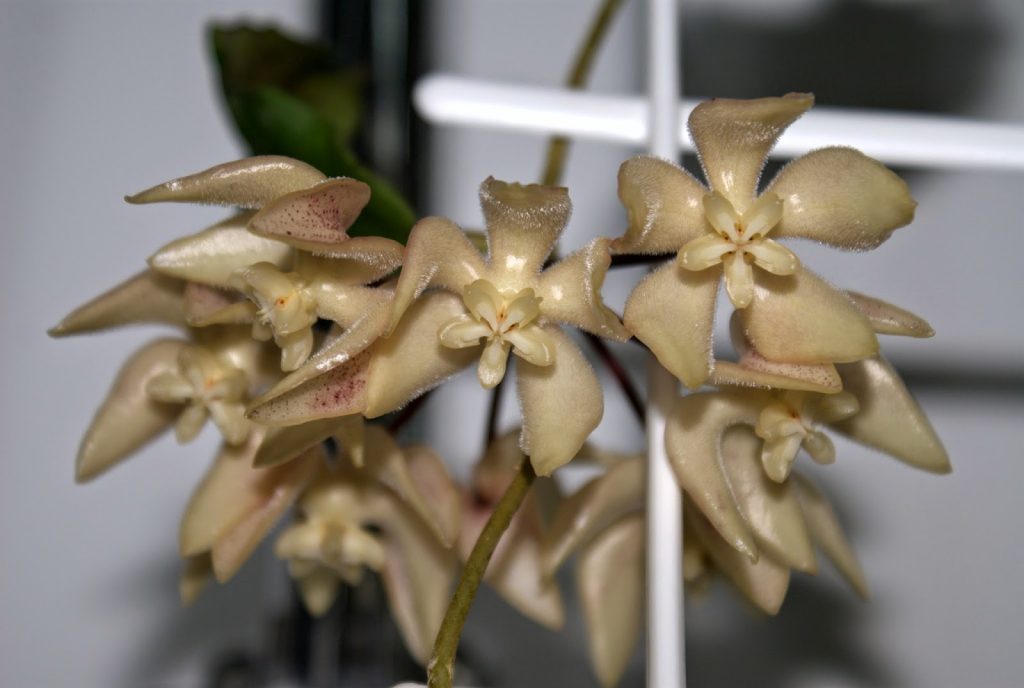Hoya Undulata - general information about the variety
Ornamental hoya Undulata, originally from Indonesia and western Kalimantan, got its name from the unusual wavy edges of the leaves. In nature, the flower grows at an altitude of 300-400 m above sea level. Consider the features of the variety, the rules of care and growing at home.

Hoya undulata
External description
Epiphytic liana Hoya undulata has another name - wavy hoya. It has thin shoots (3-5 mm in diameter) and internodes of different lengths - from 1 to 20 cm.
Stems are weakly leafy, leaves are formed only in some parts. The leaf plate is in the form of a cluster, convex at the base, ants often accumulate in it, equipping their own home. From above they are emerald green with purple or gray spots, the underside is green or solid purple.
The first type of leaflets is ovate or lanceolate, the second is oval, almost round.
The flowers are small, 2-4 cm in circumference, collected in inflorescences of 2-5 pcs. Outside, the petals are snow-white with reddish or burgundy blotches, inside are creamy pink. The crown is small, 1.2-1.3 cm in diameter.
During the flowering period, the plant does not thin out any aroma. The life span of the buds is 4-5 days.
Purchase and adaptation
You can buy hoya in one of the flower shops. Carefully inspect the crown - the stems, buds and leaves should not have mechanical damage, signs of disease and pests.
The substrate in the pot is fresh, without plaque and mold on the surface.
After the purchase, she is quarantined for three weeks to determine if she is sick with something or not. During this period, the flower adapts to indoor growth conditions.
Landing rules
Like other types of hoya, this variety prefers to grow in the sun, so it is placed on a south or southwest window, shaded from the sun at noon to avoid burns on the foliage.

Hoya undulata buy
It can develop well in partial shade, because in its natural environment, it lives in shady forests. But in the sun, its foliage turns into a deep purple color.
You can plant the plant in light, loose soil designed for growing flowering succulents and cacti. You can also prepare a soil mixture with your own hands - mix turf, leafy soil, sand and humus in a ratio of 2: 2: 1: 1.
Before planting, it is advisable to ignite such a mixture in the oven at a temperature of 100 ° C or spill it with boiling water.
The necessary conditions
The cultivation of this plant will be successful if it is created conditions that are as close to natural as possible.
Humidity
Prefers a moderate level of humidity - 50%. Therefore, it does not need spraying. Washing the leaves and stems with warm water is carried out purely for sanitary purposes once a month in order to wash off the dust and prevent the appearance of harmful insects.
Temperature
In spring and summer, the optimal regime is 23-25 ° С, in autumn and winter, the flower can be kept in a cool place - 15-16 ° С. At lower rates, the root system freezes and dies.
Easily tolerates drafts, but can shed foliage from sudden temperature changes. Therefore, if you are going to ventilate the room, move the plant to another room.
Illumination
Loves bright diffused light for 8 hours a day. The flowerpot can be placed on a window where the sun shines in the morning and evening.
You should not keep this vine in the northern part of the house, its variegated foliage will lose its original decorative effect, it will become pale, and the leaves will begin to stretch.
Care requirements
Caring for an exotic plant is not difficult and consists in carrying out several activities - moistening, loosening, feeding and pruning.

Hoya undulata photo
Watering
It should be moderate and regular. During the period of active growth in spring and summer, they are moistened every 3-4 days, in the cold season - one watering in two weeks is enough.
Use settled water at room temperature. The next day after wetting, the soil is loosened to avoid the formation of a crust on its surface.
Top dressing
Mineral complex fertilizers are used for cacti and succulents. They are brought in from early spring to early autumn every three weeks.
Nutrition is combined with watering to speed up the absorption of nutrients and prevent root burning.
Pruning
There is no need to form this flower at home, because it does not tolerate pruning and may die. Only twigs and leaves that have turned yellow, dried out or have been damaged by infections, parasites are cut out.
For this manipulation, a sharp and sterile instrument is taken to prevent infection with diseases.
Transfer
A purchased copy needs a transplant after three weeks of home quarantine. It is moistened, taken out of the pot. They take a container a little larger than the previous one and always with holes at the bottom. A lump with roots is poured into it, a light and nutritious substrate is poured to the top, watered.
Also, home flowers need to be transplanted - once every three years, because in the old container, over time, they become cramped and they stop growing.
You need to transplant a diseased plant if its roots are rotten. It is moistened, removed from the flowerpot, the root system is washed from soil residues, diseased areas are cut out, and immersed in a fungicide solution for an hour. Dried, transplanted into a new pot with sterile soil mixture.
Reproduction methods
There are three ways to propagate a flower at home. If you follow all the rules of cultivation technology, the result will be justified.

Hoya undulata flowering
Stem layering
On an adult plant, the strongest shoot is chosen, a 1 cm long incision is made on it, wrapped in wet moss, then tied with a film.
As soon as the roots break through the moss, they remove the bandage, cut off the shoot from the mother plant, and plant it in a mixture of peat and sand mixed in the same proportion.
Cuttings
This is the most popular method used by flower growers. Cuttings are cut in the spring or summer during the active growth phase. Cut off segments 15-20 cm long with 2-3 leaves and buds. All the leaves are cut off from below, dipped in Kornevin's solution for half an hour. Then they are planted to a depth of 3 cm in a peat-sandy substrate.
For fast rooting, cuttings are provided with stable heat within 23-25 ° C and regular moisture. As soon as they release 2 pairs of leaves, they are seated in separate flowerpots.
Sheet
Several thick and adult leaves with axillary buds are selected, pinched off the stem, dipped in Kornevin's solution, planted in a peat-sand mixture. To make them take root faster, they are covered with transparent film or glass. Ventilate daily, moisten as the substrate dries.

Hoya undulata care
After 2-3 weeks, if done correctly, they will take root.Then the shelter is removed, grown for another 1-2 years, until the stems appear. Then they are seated separately.
Diseases and pests
Cultivating hoya Undulata, flower growers often have to deal with various infections and parasites, which lead not only to the loss of decorativeness, but also death.
| Diseases and pests | Signs | Treatment | Prophylaxis |
| Spider mite, scale insect, aphid, mealybug | These are sucking parasites that feed on the sap of foliage, buds, and young growth. The damaged areas begin to turn yellow, become covered with spots of black or brown color, curl and dry out | First, all non-viable parts are removed, then the crown and soil are irrigated with insecticides - Aktellik, Aktara, Fitoverm or Decis | Using sterile soil for planting, replanting, regular irrigation, cutting out diseased and dead parts, buying healthy flowers |
| Root rot | Appears in plants that are often poured with cold water. First, the root rots, then the rot goes to the branches. They become soft, watery, darken, leaves massively turn yellow and crumble | The flower is removed from the pot, if all the roots have rotted, they are disposed of. Before discarding, cut off the leaves or stems for further reproduction. With a minor lesion, the decayed roots are pruned to healthy tissue, dipped in a fungicide solution for an hour. Then dried, planted in a pot with sterile soil mixture | Avoid overflow, use warm water for irrigation |
| Powdery mildew | It manifests itself in the form of a whitish bloom on the leaves, stems, buds. Organs infected with a fungal infection darken, then begin to rot and die | Remove all affected areas, treat the crown and substrate with Skor, Hom or Ridomil Gold | Buy healthy flowers, cut off yellowed, dried and rotten shoots, leaves in time, observe the watering regime and the level of humidity in the room |
| Bacterial spot | The leaves are covered with black or brown spots. Over time, they cover the entire leaf plate, it dries and dies | Remove all bad leaves, treat the crown with antibacterial drugs or fungicides | Use sterile soil for planting and transplanting |

